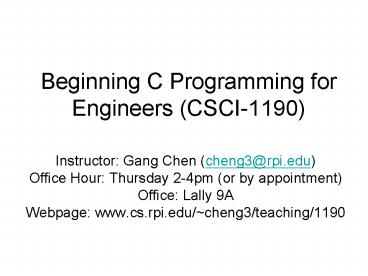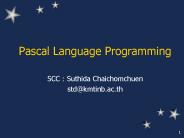Beginning C Programming for Engineers CSCI1190 - PowerPoint PPT Presentation
1 / 15
Title:
Beginning C Programming for Engineers CSCI1190
Description:
If you are not sure, look up in Appendix C. Operator Precedence Charts, p1193. Decrement ... Multiplication. Subtraction. Addition. Arithmetic Operators: An ... – PowerPoint PPT presentation
Number of Views:35
Avg rating:3.0/5.0
Title: Beginning C Programming for Engineers CSCI1190
1
Beginning C Programming for Engineers (CSCI-1190)
- Instructor Gang Chen (cheng3_at_rpi.edu)
- Office Hour Thursday 2-4pm (or by appointment)
- Office Lally 9A
- Webpage www.cs.rpi.edu/cheng3/teaching/1190
2
Basic Computer Model
CPU
Input
Output
Memory
Instructions Data
Von Neumann Architecture
3
Programming Languages
1300042774 1400593419 1200274027
Machine Languages
LOAD A ADD B STORE C
Assembly Languages
CAB
High-Level Languages
4
Creating Programs
C libaray
hello.o
compile
hello
hello.c
Link
Edit
Source File (High-Level Languages)
Object File (Machine Languages)
Executable
gcc o hello hello.c
nedit hello.c
5
Unix Commands
6
Hello, World
- / Hello, world program /
- include ltstdio.hgt
- int main()
- printf("hello, ")
- printf("world\n")
- return 0
- Editing xemacs hw.c or nedit hw.c or vi hw.c
- Compiling gcc Wall o hello hw.c
- Executing hello
7
Basic Programming Concepts
- Comment To explain what the program is for and
why it is the way it is. - Preprocessing Done before the program is
compiled. - To include header files containing information
about C libraries - Statement A line of code that tells computer to
perform some action. Always ended with a
semicolon(). - Invoking functions
- Function A module often consisting of a set of
statements. - Two functions in the hello world program main,
printf
8
In Class Exercise 1-1
- Escape Sequences are used to control printf to do
something other than printing characters. - Modify the hello world program to try out various
escape sequences like - \n Newline. Position cursor at the beginning of
the next line. - \t Tab. Move cursor to the next tab stop.
- \a Alert. Sound the system bell.
9
Arithmetic Operators
- To form expressions
- Many statements are merely expressions.
- Normal order of operations is followed.
Parentheses can be used. - If you are not sure, look up in Appendix C.
Operator Precedence Charts, p1193
10
Arithmetic Operators An Example
- / Arithmetic operators /
- include ltstdio.hgt
- int main()
- printf("73d\n",73)
- printf("7-3d\n",7-3)
- printf("73d\n",73)
- printf("7/3d\n",7/3)
- printf("73d\n",73)
- printf("7.0/3.0f\n",7.0/3.0)
- return 0
11
Variables
- Variable Name for a memory object. Variable
names must start with letters and contain
letters, digits, and underscores. - a, b, i, j, counter, number_of_points, c1234,
- Type What the variable represents. Could be of
integer, floating point number, character,
string, and many others. - int, float, double, char,
- Declaration Tells compiler about variables and
their type. - int i,j
- float sum
12
Numeric Types
13
Reading Inputs
- include ltstdio.hgt
- int main()
- float a,b
- printf("Please input the first
number\n") - scanf("f",a)
- printf("Please input the second
number\n") - scanf("f",b)
- printf("abf\n",ab)
- printf("a-bf\n",a-b)
- printf("abf\n",ab)
- printf("a/bf\n",a/b)
14
Assignment
- / Arithmetic operators /
- include ltstdio.hgt
- int main()
- int a,c
- int b4
- a3
- cab
- printf(Sum d d -gt d\n,a,b,c)
- ab--
- prinf(Now ad and bd\n,a,b)
- return 0
15
In-Class Exercise 1-2
- Write a program to calculate the average of three
floating point numbers, namely 2.3, 3.4, 4.5. - Using scanf function
- Using assignment































